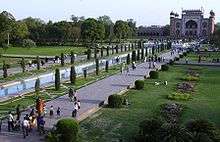Paradise garden
The paradise garden is a form of garden of Old Iranian origin, specifically Achaemenid. Originally denominated by a single noun denoting "a walled-in compound or garden", from "pairi" ("around") and "daeza" or "diz" ("wall", "brick", or "shape"), Xenophon Grecized the Persian phrase "pairi-daeza" into "Paradeisos".[1] The idea of the enclosed garden is often referred to as the paradise garden because of additional Indo-European connotations of "paradise".
Qualities
The essential qualities of the paradise garden derive from its original, arid or semi-arid homeland. The fundamental quality is enclosure of the cultivated area, which excludes the wildness of nature and includes cultivated and irrigated greenery, providing privacy and security. The most common design of the perimeter walls is that of a rectangle, and this forms one of its primary qualities. Another common quality is the elaborate use of water, often in canals, ponds, or rills, sometimes in fountains, and less often in waterfalls. The rectangular or rectilinear design is often extended to the water features, which typically quarter the garden. This design derives from or is echoed in that of the Garden of Eden, which in Genesis is described as having a central spring that feeds four rivers, which each flow out into the world beyond. Much of the use and symbolism of the paradise garden is derived from the Garden of Eden. It was designed to symbolize eternal life. A tree with a spring issuing from its roots especially symbolizes this. Additionally, the contrast of a formal garden design with the informality of freely growing plants is a recurring theme in many paradise gardens. Odor and fruit are important elements of this garden.
Derived garden types
The paradise garden is one of the few original and fundamental kinds of garden from which all gardens in history derive, sometimes in combinations. In its simplest form, the paradise garden consists of a formal, rectangular pool, having a flow just sufficient to give it movement, and with a dais from which to observe it. However, a pavilion provides more permanent shelter than the original tent. Strictly aligned, formally arranged trees, especially the chenar or Platanus, provide shade.
The Achaemenid kings built paradise gardens within enclosed royal hunting parks, these being a different tradition of landscape gardening, which they inherited from the Assyrians, for whom the ritual lion hunt was a rite that authenticated kingship, being far more than a mere sport.
Many of the Islamic horticultural traditions and later European traditions derive from that of the paradise garden. Examples of the paradise garden and its derivations are present in many of the historic gardens of Islamic and European nations. In the east, by way of the Persian garden it gave rise to the Mughal gardens of India, a late example of which is the garden of the Taj Mahal in Agra. In the farthest west, it informed the paved and tiled courtyards, arcades, and pools and fountains of Moorish Andalusia. The fundamental design of the Gardens of Versailles in France almost replicates the paradise gardens of Pasargad, and the gardens of the Louvre in Paris appear inspired by them. Another example is the Bahá'í Terraces and Mansion of Bahjí on Mount Carmel in Israel, both of which have extensive gardens of intricate design.[2]
See also
- Islamic garden
- Persian Gardens and bagh (garden)
- Mughal Gardens
- Landscape design history
- History of gardening
- Howard Finster
- A Village Romeo and Juliet
- Sasanian defense lines
References
- ↑ Penelope Hobhouse; Erica Hunningher; Jerry Harpur (2004). Gardens of Persia. Kales Press. pp. 7–13.
- ↑ Yael Hammerman: Distinctive Design of the Bahá’í Gardens
Further reading
- Lehrman, Jonas Benzion (1980). Earthly paradise: garden and courtyard in Islam. University of California Press. ISBN 0520043634.
- Villiers-Stuart, C. M. (1913). The Gardens of the Great Mughals. Adam and Charles Black, London. Online text of history of Indian gardens.


-Jerusalem-Temple_Mount-Dome_of_the_Rock_(SE_exposure).jpg)